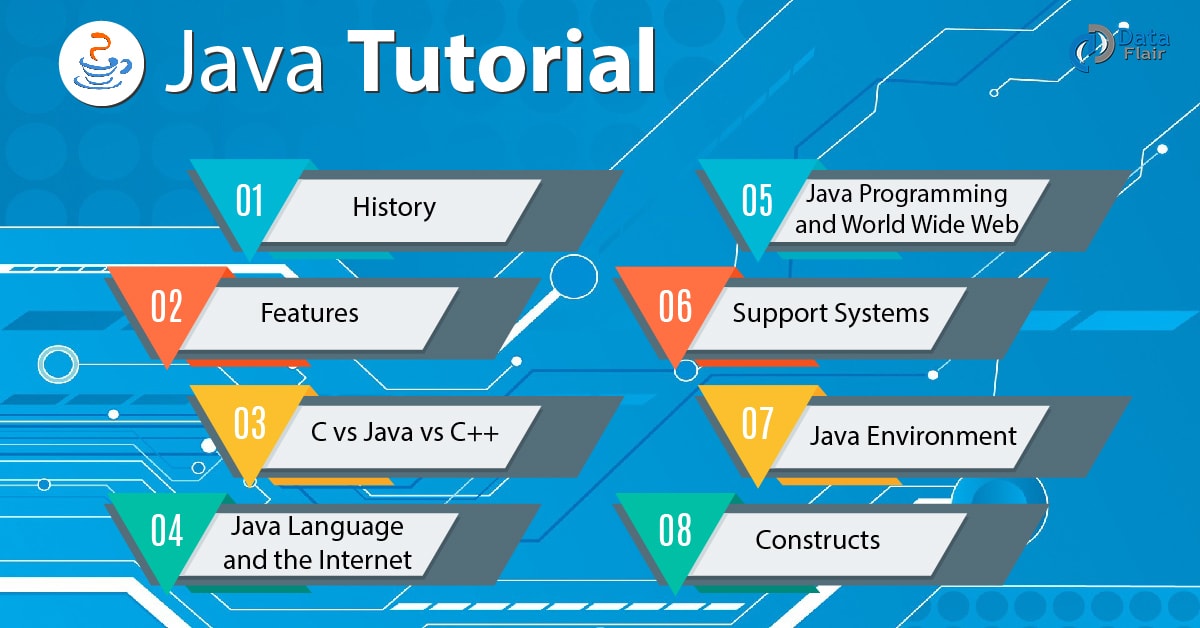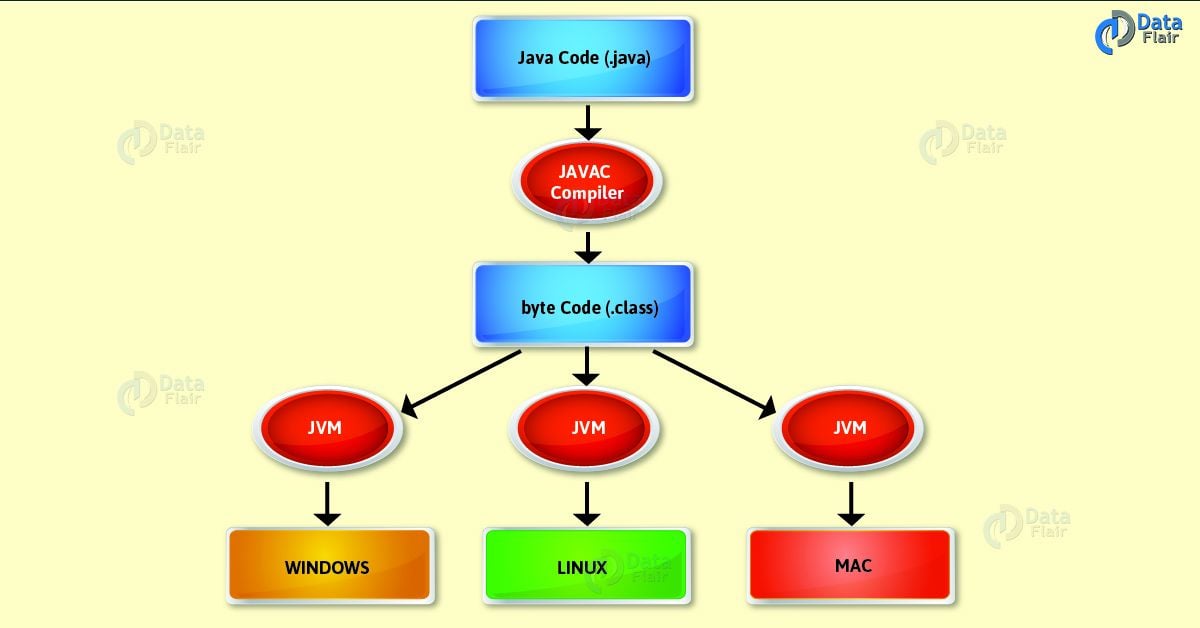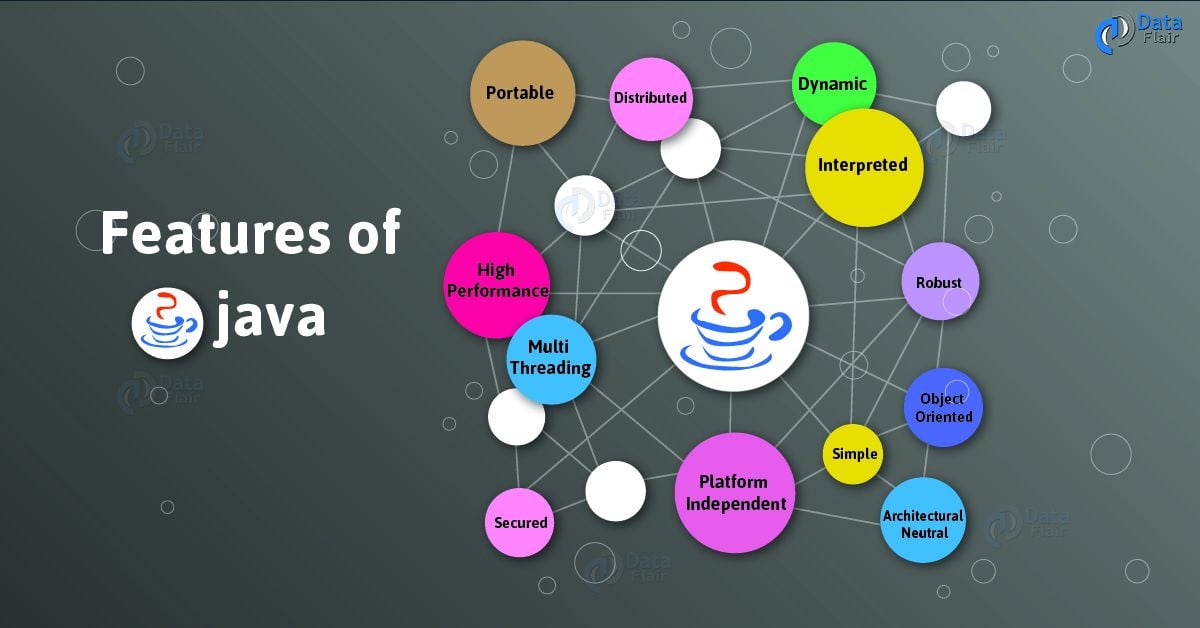Java Tutorial for beginners – Expert in Java Programming in 10 Days
Free Java courses with 37 real-time projects - Learn Java
Java Tutorial – Objective
In this Java tutorial for beginners, we are going to learn about java evolution, development of Java language, java features, Java frameworks, and Java support systems. Java tutorial covers various development tools, classes in Java programming, and Java methods which comprises the Java environment. This tutorial on Java will help you get a quick insight into the Java programming language and thus, help you learn java language.
So, let’s start Java programming for beginners.
What is Java Programming Language?
Java Programming is a general-purpose object-oriented programming language, designed for the development of software for consumer electronic devices such as TVs, VCRs, toasters, etc.
Java Programming Language is a platform neutral language, which means it is not tied to any particular hardware or operating system. It guarantees users to ‘write once, run anywhere’. Java language is supported by almost every operating system such as Sun Solaris, RedHat, Windows etc.
The Java programming language was developed by Sun Microsystems of the USA in 1991, it was originally called Oak by James Gosling, who was one of the inventors of the language. The main goal for the developers was to make the language highly reliable, portable and simple.
The team for the development of Java language included Patrick Naughton, who discovered that the existing languages such as C and C++ had some major drawbacks in terms of reliability and portability. They modeled the new language Java on C and C++ while removing some features that they considered as constraints. This made Java a really simple, portable and powerful language. To learn java basics, let’s revise Java syntax.
History of Java
Java tutorial for beginners stats the evolution of Java Programming:
a. 90’s
- 1990 – A team of Sun Microsystems programmers decided to develop special software to manipulate consumer electronic devices. The team headed by James Gosling
- 1991 – The team studied various languages present at that time, viz., C and C++ and announced the new language to “Oak”.
- 1992 – The team at Sun known as Green Project demonstrated the application of their new language. For example, to control a list of home appliances using a hand device with a tiny touchscreen.
- 1993 – The World Wide Web came to the internet and transformed the text-based Internet into the graphical rich environment. The Green Project team came up with the idea of developing Web applets (tiny programs) that could run on all types of computers connected to the internet.
- 1994 – The team developed a web browser called “HotJava” to locate and run applet programs on the internet. This made it immensely popular amongst internet users.
- 1995 – Oak was renamed as “Java”, due to some legal snags. Java is a name, no acronym.
- 1996 – Java programming was established as the leader for internet programming and also as a general-purpose object-oriented programming language. Sun releases Java Development Kit 1.0.
- 1997 – Sun releases Java Development Kit 1.1 (JDK 1.1)
- 1998 – Sun releases the Java 2 with version 1.2 of the Software Development Kit (SD K 1.2)
- 1999 – Sun releases Java 2 platform, Standard Edition (J2SE) and Enterprise Edition (J2EE)
b. 2000’s
- 2000 – Release ofJ2SE with SDK 1.3.
- 2002 – The release of J2SE with SDK 1.4.
- 2004 – The release of J2SE with JDK 5.0 (instead of JDK 1.5), known as J2SE 5.0.
- 2006 – The release of Java SE 6.
- 2011 – The release of Java SE 7.
- 2014 – The release of Java SE 8.
- 2017 – The release of Java SE 9.
Features of Java Programming
The main goal of the inventors was to design a language which could offer solutions to the problems encountered in modern programming. The goal being the language to reliable, portable and distributed and at the same time simple, compact and interactive.
In the world of programming languages, Java has established itself as a mainstay. Because of its adaptability and simplicity of use, developers prefer it. The object-oriented paradigm of Java enables programmers to organize their code into reusable modules, which enhances the readability and efficiency of the code. Additionally, Java has an extensive standard library that is full of pre-written classes that speed up common programming tasks. Programmers can create apps that function flawlessly on a variety of operating systems thanks to this extensive library and Java’s built-in portability.
Let’s discuss some Features of Java Programming:
a. Compiled and Interpreted
Java language combines both of these approaches thus making Java a two-stage system. This approach was never offered before, as any language before was either compiled or interpreted.
Firstly, Java compiler translates source code into bytecode instructions, bytecodes are not machine instructions.
Secondly, Java interpreter generates machine code that can directly execute by the machine that is running the Java program.
b. Independent and Portable
Java programs can easily move from one system to another, anywhere and anytime. Changes or any upgrade in the operating system, processors and system resources will not force any changes in Java programs.
Java programming ensures portability in two ways: firstly, Java compiler generates bytecode instructions that can be implemented on any machine, and secondly, the size of the primitive data types are machine independent.
c. Object-oriented
Almost everything in Java language is an object, which makes it a true object-oriented language. All program code and data reside within objects and classes. Java comes with an extensive set of classes, arranged in packages, which are used in program inheritance.
d. Robust and Secure
Java language provides many safeguards to ensure reliable code. It has strict run-time checking for data types. It is designed as a garbage collected language, i.e., it captures series errors and eliminates any risk of crashing the system.
Java systems verify all the memory access and thus ensures that no virus is communicated with an applet.
e. Distributed
Java programming facilitates both, sharing of data and programs. Java applications can open and access remote objects on the Internet as easily as on any local system.
f. Simple, Small and Familiar
Java is a simplified version of C++, which is why it is familiar and yet different as it eliminates all the redundant and unreliable code. For example, Java does not use pointers, preprocessor header files, and many others. It also eliminates operator overloading and multiple inheritances in Java.
g. Multithreaded and Interactive
Multithreaded means handling different tasks simultaneously. Java language supports multithreaded programs, which means that we need not have to wait for one task to finish for another to start. This feature of Java programming greatly improves the interactive performance of graphical applications.
h. High Performance
Java programming performance is very impressive considering the fact that is an interpreted language, mainly because of the bytecodes. Java architecture is designed to reduce overheads.
i. Dynamic and Extensible
Java is a dynamic language, it is capable of dynamically linking in new class libraries, methods, and objects. It can also determine the type of class through query.
j. Ease of Development
Java 2 standard edition (J2SE) 5.0 supports features such as Generics, Enhanced for loop, autoboxing or unboxing, typesafe enums, varargs, static import and annotation. These java features make it easy for the Java programmer by shifting the responsibility of creating the reusable code to the compiler, and also the resulting code is free from bugs.
k. Scalability and Performance
J2SE 5.0 improves the startup time and reducing the amount of memory used in Java 2 runtime environment. Learn more features of Java.
Another aspect of Java’s ongoing appeal is its thriving community. For programmers at all skill levels, there are a tonne of online resources, tutorials, and forums available. The Java community offers a multitude of resources and encouragement to support your programming journey, regardless of your level of experience.
C vs Java vs C++
In this Java tutorial for beginners, you will learn the difference between C, C++, and Java programming.
a. C vs Java
The major difference between C vs Java Programming language is that Java is an Object Oriented language and has a mechanism to define classes and objects in java. The features of C which are not included in Java are:
- No unique statement keywords of C size and typedef.
- No data types such as struct and union.
- Java does not define the type modifier keywords such as auto, extern, register, signed and unsigned.
- No support for pointer type.
- Non-availability of preprocessor
- Java requires that the function with no argument must declare with empty parenthesis and with the void keyword.
- New Java operators such as instanceof and >>>.
- Java programming has label bcontinues continue statements.
b. Java vs C++
The main difference between c++ vs Java is that Java is a true Object-oriented language while C++ just adds an object-oriented extension to C. The increment operator in C++ indicates the same thing.
The list of features, below intentionally omit from Java language to make it better.
- No support for operator overloading.
- No template classes as in C++.
- A new feature called “interface” in Java programming and thus not supporting multiple inheritances.
- Java language does not support global variables.
- Java uses a finalize () function instead of the destructor function.
- There are no header files in Java programming.
Let’s discuss Java Regular Expression and Java Array.
Java Language and the Internet
In this section of Java tutorial for beginners, we will explore how the internet and Java are related?
The Java Programming is often called Internet language because the first application program written in Java was HotJava, a Web browser to run applets on the Internet. Internet users can use Java to create applets and run them locally using HotJava. A Java-enabled browser to download an applet located anywhere on the Internet can also use.
Java applets have made the Internet a true extension of the storage system on local computers. Internet users can also set up their websites containing Java applets that could use by remote users.
Java Programming and World Wide Web
Do you know how Java and WWW are related?
World Wide Web (www), an information retrieval system where any information or file identify as Uniform source Locators (URLs) and are interlinked via hypertext links. WWW can access with the help of internet.
Internet and Java programming, both had the same philosophy and thus they were incorporated with each other easily. Java made it possible for the World Wide Web to support animation, graphics, games, and a wide range of special effects.
To communicate with any web page, Java uses APPLETs. The steps involved are –
- The user requests for a hyperlink document a to remote computer’s web server. (a web server receives, processes, and sends the requested document)
- The document contains the APPLET tag, which identifies the applet.
- Java source code file compiles the bytecode for that applet, which is then transferred to user’s computer.
- The browser which is enabled by Java programming then interprets the bytecode and provides the output.
Java Support Systems
The operations of Java language and Java-enabled browsers on the internet requires a variety of support systems, namely,
- Internet Connection
- Web server
- Web Browser
- HTML- A language for creating hypertext for the web.
- APPLET tag
- Java code
- Bytecode
- Proxy Server-an intermediate server between the requesting client workstation and the original server.
- Mail Server
Java Environment
It includes a large number of java development tools and java classes and methods.
The Java development tools are part of the system known as Java Development Kit (JDK) and the classes and the methods in Java are a part of the Java Standard Library (JSL), also known as the Application Programming Interface (API).
a. Java Development Kit
Java Development Kit includes-
- appletviewer (for viewing Java applets)
- javac (Java compiler)
- java (Java interpreter )
- javap (Java disassembler)
- javah (for C header files)
- javadoc (for creating HTML files)
- jdb (Java debugger)
b. Application Programming Interface
The Java Standard Library includes classes and packages, some most commonly used packages are-
Language Support Package- A collection of Java classes and methods required for implementing basic features of Java.
- Utility Package- To provide java utility functions.
- Input/output Package– For java input/ output manipulation.
- Networking Package– For communicating via the internet.
- AWT Package- The abstract window toolkit package contains classes that implement platform independent graphical user interface.
- Applet Package- It allows to create Java applets.
c. Java Runtime Environment
It facilitates the execution of Java programs, comprising-
Java Virtual Machine (JVM) – It interprets the intermediate Java bytecode and generates the desired output.
- Runtime class libraries- These are a set of core Java class libraries for execution of the java program.
- User interface toolkits- Used for interaction with the Java application program.
- Deployment technologies
1)Java plugin- Enables the execution of a Java applet.
2) Java Web start- Enables an application to directly launch from the web browser without installing. Learn more about Java Datatypes and Java Modifiers.
Java Constructs
Constructs are basically reserved keywords in any language, that cannot be used in rest of the programs, i.e., as name of variables in Java, class or method. Java has around 50 such words, they are-
| abstract | for | new | enum | super |
| assert | goto | package | extends | switch |
| boolean | if | private | final | synchronized |
| break | implements | protected | finally | this |
| byte | import | public | float | throw |
| case | instance of | continue | while | throws |
| catch | int | default | return | transient |
| char | interface | do | short | try |
| class | long | double | static | void |
| const | native | else | strictfp | volatile |
You can access a wide range of professional options by becoming proficient in Java. In today’s job market, knowing Java is highly desirable due to its widespread use in application development. Proficiency in Java sets you up for success in a variety of industries, such as telecommunications, healthcare, and finance.
So, this was all about the Java Tutorial for beginners. Hope you like our explanation.
Summary for Java tutorial for beginners
Finally, in this Java tutorial, we learned about the history of Java programming language, java features, how java is different from C and C++, how it incorporates in World Wide Web with help of Web browsers and the environment required for running Java applications. Furthermore, if you have any query, feel free to ask in the comment box.
See also- Best Java Book
You give me 15 seconds I promise you best tutorials
Please share your happy experience on Google








Thank you; I learned a lot.
Hi Robert
Thanks for visiting our Java Tutorials.
Very happy that you have learned many things from here. Check out our more blogs, especially the blogs that can help you to make a good career in Java technology.
Here is the link for you
https://data-flair.training/blogs/java-career-opportunities/
You can also check our Java tutorials home, there you can get a complete series of Java. Must visit.
https://data-flair.training/blogs/java-tutorials-home/
Keep learning
Regards from Data Flair
thanku for this tutorial
i have learned alot and many basic and importants things from there
thanks
We are glad you like our Java tutorial. Our team always try to provide the required information to the reader. You can refer our sidebar and menu bar for more tutorials.
Regards,
Data-Flair
Thank you very much. I really liked what I learned.
Hi Sofia,
Thanks for visiting DataFlair and commenting on Java Programming Tutorial. We have a bunch of Java tutorial for beginners to experts on our sidebar as well as series of Java interview questions and quizzes. Please refer them as well. We hope you will have the experience as you had now.
happy to learn here,very useful.
Hello, Latha
Thanks for connecting with us through this Java Tutorial for beginner. We have 100+ Java tutorial, which will help you to learn Java Programming easily.
Take the tutorial series from left sidebar and complete it.
Regards
DataFlair
switch is misspelled
quiz question color not changing in any tutorials